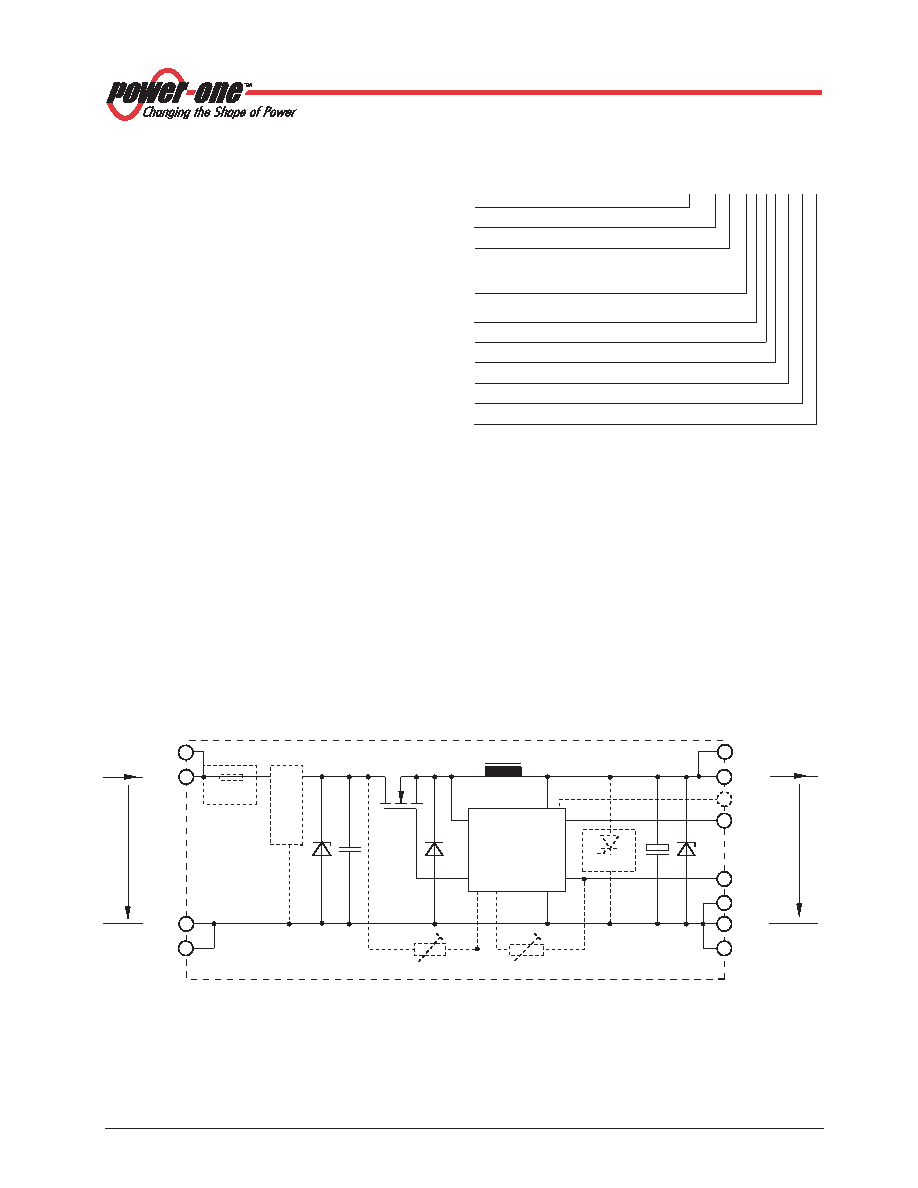- 您現(xiàn)在的位置:買賣IC網(wǎng) > PDF目錄69124 > PSC158-7IP (POWER-ONE INC) 1-OUTPUT DC-DC REG PWR SUPPLY MODULE PDF資料下載
參數(shù)資料
| 型號: | PSC158-7IP |
| 廠商: | POWER-ONE INC |
| 元件分類: | 電源模塊 |
| 英文描述: | 1-OUTPUT DC-DC REG PWR SUPPLY MODULE |
| 文件頁數(shù): | 6/13頁 |
| 文件大?。?/td> | 223K |
| 代理商: | PSC158-7IP |

PSC Series Extended Data Sheet
Positive Switching Regulators (Industrial)
REV. MAY 12, 2004
Page 2 of 13
Part Number Description
PSC 12 8 -7 L i R P C D
Positive switching regulator in case C03 .................... PSC
Nominal output voltage in volt (5A for 5.1 V) ......... 5A - 36
Nominal output current in ampere ............................ 8 - 12
Operational ambient temperature range
T
A
–25 to 71°C ......................................................... -7
–40 to 71°C (option) ............................................ -9
Input filter (option) ............................................................ L
Inhibit input ....................................................................... i
Control input for output voltage adjustment 1 .................. R
Potentiometer 1 (option) ................................................... P
Thyristor crowbar (option) ............................................... C
Input/output voltage monitor (option) ......................... D/D1
1 Feature R excludes option P and vice versa.
Example:
PSC 128-7LiPC = A positive switching regulator with a 12 V, 8 A output, ambient temperature range of
–25 to 71°C, input filter, inhibit input, output adjust potentiometer and thyristor crowbar.
Control circuit
Option P
Go–
Vo+
Gi–
Vi+
Input
Filter
Option
L
G
R
i
D (option)
Io
Vo
I i
Vi
Option C
Fuse1
03018
Option D
Vt
Vo
1 Fuse fitted for option
Fig. 1
Block diagram
Functional Description
The switching regulators are designed using the buck con-
verter topology. See also:
Technical Information: Topolo-
gies. The input is not electrically isolated from the output.
During the on period of the switching transistor, current is
transferred to the output and energy is stored in the output
choke in the form of flux. During the off period, this energy
forces the current to continue flowing through the output, to
the load and back through the freewheeling diode. Regula-
tion is accomplished by varying the on to off duty ratio of the
power switch.
These regulators are ideal for a wide range of applications,
where input to output isolation is not necessary, or where
already provided by an external front end (e.g. a trans-
former with rectifier). To optimise customer’s needs, addi-
tional options and accessories are available.
相關(guān)PDF資料 |
PDF描述 |
|---|---|
| PSC158-9LIR | 1-OUTPUT DC-DC REG PWR SUPPLY MODULE |
| PSC158-7IRD | 1-OUTPUT DC-DC REG PWR SUPPLY MODULE |
| PSC368-7LIPCD | 1-OUTPUT DC-DC REG PWR SUPPLY MODULE |
| PSC128-9LIR | 1-OUTPUT DC-DC REG PWR SUPPLY MODULE |
| PSC368-7IRCD1 | 1-OUTPUT DC-DC REG PWR SUPPLY MODULE |
相關(guān)代理商/技術(shù)參數(shù) |
參數(shù)描述 |
|---|---|
| PSC158-7IR | 功能描述:SWITCHING REGULATOR 120W 15V RoHS:是 類別:電源 - 板載 >> DC DC Converters 系列:* 標準包裝:5 系列:* |
| PSC158-9IR | 制造商:Power-One 功能描述:DC/DC PS SGL-OUT 15V 8A 120W 9PIN - Bulk |
| PSC159-2 | 功能描述:SWITCHING REGULATOR 135W 15V RoHS:是 類別:電源 - 板載 >> DC DC Converters 系列:* 標準包裝:5 系列:* |
| PSC159-2IR | 制造商:Power-One 功能描述: |
| PSC-15A-050 | 功能描述:插入式交流適配器 U 552-PSC-15A-050S 15W 5VDC WALL ADAPT RoHS:否 制造商:Phihong 地區(qū):Universal 安裝風格:Wall, Interchangeable Plug 輸入電壓范圍:90 VAC to 264 VAC 輸出端數(shù)量:1 輸出功率額定值:5 W 輸出電壓(通道 1):5 V 輸出電流(通道 1):1 A 直流輸出連接器:USB Type A 隨附/必需的交流插頭:Required 商用/醫(yī)用:Commercial 效率:Level V |
發(fā)布緊急采購,3分鐘左右您將得到回復(fù)。